Exploring the Formation of Freshwater Pearls
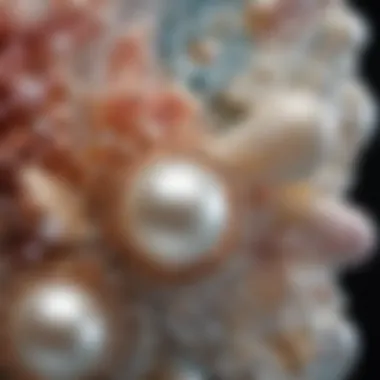
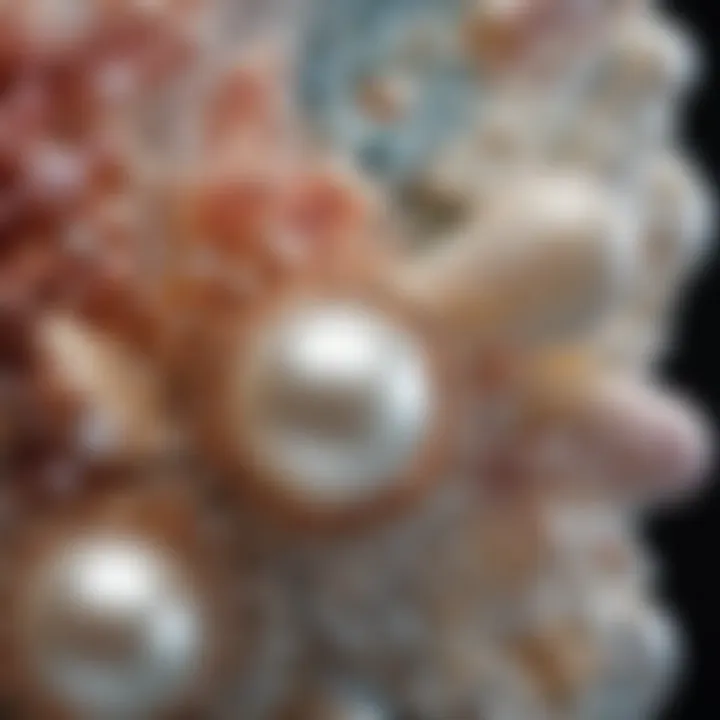
Intro
Freshwater pearls, known for their unique charm and diverse colors, hold a special place in the world of gemstones. Unlike their saltwater counterparts, these gems form within the soft tissue of freshwater mussels, which can be found in rivers and lakes. Their allure and elegance come not just from their beauty, but also from the fascinating journey they take from formation to harvest. Understanding this process gives us deeper appreciation for these natural wonders.
The exploration of the formation of freshwater pearls involves a complex interplay of biological mechanisms as well as environmental influences. Each pearl has its own tale to tell, influenced by the conditions in which it grew, the materials available, and even the techniques applied by farmers who cultivate them.
This article seeks to unravel the mystery surrounding freshwater pearls, offering an insightful look into how they are formed, the factors that can enhance or detract from their quality, and the various methods employed in their cultivation. We aim to guide both novices and experienced enthusiasts through this captivating subject, shedding light on the unique attributes of freshwater pearls compared to their saltwater relatives.
As we dive into the specifics, readers will discover the remarkable synchronicity between nature and the artisanal practices that contribute to pearl production. By the end of this exploration, the intricate world of freshwater pearls will unfold, revealing their beauty, significance, and the secrets behind their formation.
Understanding Freshwater Pearls
Understanding freshwater pearls is not just for enthusiasts or collectors, but for anyone curious about these unique creations of nature. This section paves the way for grasping the deeper elements of pearl formation, leading us into a world where biology and art collide. Freshwater pearls are often prized more than their saltwater cousins due to their organic beauty and diversity in shape and color, illuminating a significant niche in the gemstone realm.
Definition and Characteristics
Freshwater pearls are formed within the soft tissue of freshwater mollusks, primarily mussels. They are typically round, but they can also take on various shapes, such as baroque or button. This variance occurs because unlike marine oysters that predominantly create round pearls, the mussels are less picky about the shape they produce. The luster of a freshwater pearl tends to be softer and silkier, often exhibiting a unique charm.
One defining characteristic is the wide array of natural hues they come in, ranging from soft pastels to rich blues and even vibrant purples. This color spectrum is a result of the specific mollusk and the environmental conditions where they grow, adding layers of aesthetic appeal. Additionally, freshwater pearls are usually less expensive than saltwater pearls. This aspect makes them accessible and desirable for various types of jewelry, catering to a broader audience.
"The allure of freshwater pearls lies in their individuality; no two are alike, each telling its own story of formation and growth."
Comparison with Saltwater Pearls
The distinction between freshwater and saltwater pearls is crucial for understanding their formation processes and market dynamics. Saltwater pearls, primarily produced by the Pinctada genus of oysters, are typically spherical and exhibit a higher lustre. They command a higher price due to their limited production and the specific conditions needed for cultivation.
In contrast:
- Mollusk Species: Freshwater pearls can come from various types of mussels, while saltwater pearls are harvested mainly from oysters.
- Shape & Size: Freshwater pearls are available in diverse shapes, including oval and baroque forms, and they are often smaller than saltwater pearls.
- Growth Time: Freshwater pearls can be harvested more quickly, typically within 6 months to 2 years, compared to saltwater pearls, which generally require 2 to 4 years to reach maturity.
- Cost: Due to the differing levels of rarity and cultivation costs, freshwater pearls tend to be more affordable, aiding their appeal for casual wear.
In summary, understanding the uniqueness of freshwater pearls not only highlights their biological and aesthetic significance but also differentiates them in the vast world of pearls. With a foundation laid on these principles, we can delve deeper into the biological processes that bring these gems to life.
Biological Processes Behind Pearl Formation
Exploring the biological processes behind pearl formation is crucial for understanding how freshwater pearls develop their unique characteristics. This section delves into the interplay between mollusks and the environmental influences determining the quality and type of pearls produced. Understanding these processes not only enlightens pearl enthusiasts but also aids collectors and jewelry designers in making informed choices.
Role of the Mollusk
Mollusks are the unsung heroes in the world of pearl formation. They are the creatures responsible for producing pearls, specifically those belonging to the families of freshwater mussels and clams. When an irritant, such as a grain of sand or a parasite, enters the mollusk's shell, it triggers a natural defense mechanism. This defense mechanism leads the mollusk to secrete a substance called nacre, which is layered around the irritant.
Mollusks display fascinating behaviors during this process. Some species like the Hyriopsis cumingii, known for its ability to produce colorful pearls, develop a thick layer of nacre as a protective response. This not only encases the foreign object but also gives rise to the lustrous surface we admire in pearls today. It's a bit like how one might throw a blanket over a mess—tucking it away, hoping it stays unnoticed.
Moreover, the health and species of the mollusk play a vital role in determining the characteristics of the pearl. Factors such as genetics, age, and environmental conditions all influence how well a pearl is formed. A healthy mollusk yields high-quality pearls, showcasing a richer luster and more vibrant colors.
Nacre and Its Significance
Nacre, often referred to as mother-of-pearl, is the shimmering material that gives pearls their unique beauty and shine. Its formation is central to the pearl-making process. When a mollusk secretes nacre in layers, it does so in a controlled manner that can take years to produce a single, significant pearl. Each layer adds to the overall thickness and smoothness of the pearl, contributing to its appeal.
The significance of nacre extends beyond aesthetics. It is composed of aragonite or calcite crystals, both calcium carbonate minerals, and these structural components play a pivotal role in the pearl’s durability. The more layers of nacre a pearl contains, the more valuable it becomes. Pearls high in nacre thickness often exhibit greater luster and iridescence.
One might think of nacre in the same way as make-up; it’s how layers of color, shine, and texture come together to create the final look. Moreover, variations in nacre deposition that respond to external environmental factors can lead to diverse patterns and hues, making each pearl distinct.
"The allure of a pearl is often found in the story of its creation, reflective of time, nature, and the resilience of life."
The Stages of Pearl Formation
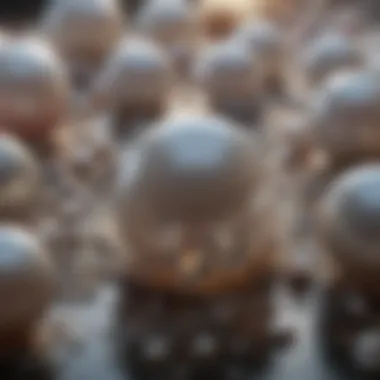
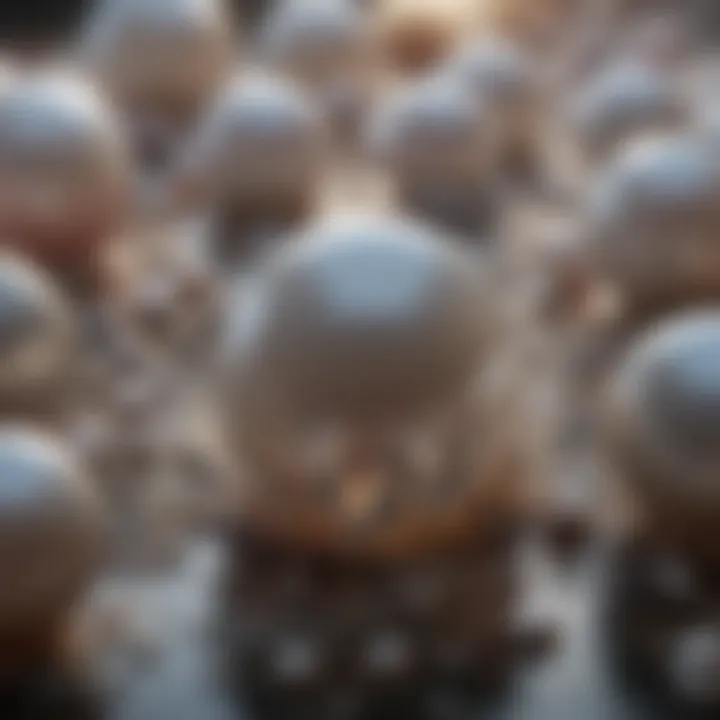
The process of forming a freshwater pearl is a fascinating journey, akin to nature crafting a gem over time through a series of intricate stages. Understanding these stages not only highlights the beauty of pearls but also informs enthusiasts and collectors about what to expect when acquiring these treasures. This section will break down the phases of pearl formation, emphasizing the significance of irritation, the layering process, and the timeline required for a pearl to fully develop.
Irritation and Response
At the very heart of pearl formation lies the concept of irritation. A freshwater mussel, usually belonging to the family Unionidae, encounters an irritant, which can be anything from a grain of sand to a parasite. Though it may seem counterintuitive, the reaction of the mollusk to this discomfort sets the stage for pearl creation.
When faced with this irritant, the mollusk wraps it in layers of nacre, a substance secreted by the mantle tissue. Nacre is composed primarily of aragonite, a form of calcium carbonate, along with a protein called conchiolin. This natural defense mechanism serves both to protect the mollusk and to encapsulate the irritant, gradually transforming it into a lustrous pearl over time.
"The irritation prompts the mollusk to create layers of nacre; this is how a simple irritant turns into a lustrous gem."
This interaction between the mollusk and the irritant is essential, illustrating a raw yet delicate process. As the mollusk continues to deposit layers of nacre upon the irritant, the transformation begins, setting the groundwork for what will eventually become a stunning pearl.
Layering Process
Once the irritation has triggered the response, the pearls layering process takes center stage. The mollusk continues to secrete nacre, building up layers upon layers around the irritant, which can resemble a swaddled baby wrapped in a comforting blanket.
The layers of nacre can range in thickness, influenced by various factors, including the health of the mussel, the availability of resources, and environmental conditions. Each layer contributes to the final appearance of the pearl, affecting its luster, shape, and color. These layers develop like the rings of a tree, granting insight into the pearl’s growth history.
Visual appeal is the result of not just the thickness, but also how well the nacre layers were applied. A pearl with many fine layers is generally more desirable and valuable than one with fewer, thicker layers, as they result in a more iridescent and smooth surface, reflecting light beautifully. This makes the layering process crucial, translating the mollusk's effort into a gem that captivates the eye.
Timeframe for Growth
The timeframe for pearl growth can be quite variable. Generally, it takes anywhere from two to six years for a freshwater pearl to reach maturity. However, this duration can fluctuate based on several factors.
- Mollusk Health: A healthy mussel is a prolific producer. If environmental conditions are optimal, growth can be expedited.
- Water Quality: Clear, pollution-free water leads to healthy mollusks, boosting their growth speed and improving nacre layering.
- Temperature and Climate: Warm temperatures typically enhance metabolic rates, impacting how quickly a pearl develops.
It's fascinating to note that not all pearls take the same path. Those that grow in a nurturing environment may form quicker and exhibit richer colors than those in less favorable conditions. Therefore, it's essential to consider these variables when discussing the overall quality and value of a pearl.
Factors Influencing Pearl Quality
The quality of freshwater pearls is a multifaceted topic, shaped by various environmental and biological elements. Understanding these influences is crucial for anyone engaged in the pearl industry, whether you're a collector, jeweler, or simply an enthusiast. High-quality pearls aren’t just a matter of luck; they emerge from specific conditions in their habitat. In this section, we delve into the key factors that impact the development and overall quality of freshwater pearls, making it an essential area of exploration.
Water Quality
Water quality plays an indispensable role in the formation of pearls. Clear, clean water laden with the proper minerals and nutrients creates the ideal environment for mollusks to thrive. Polluted or turbid waters can stunt pearly growth or even prevent mollusks from forming any pearls at all.
Key Elements of Water Quality:
- Mineral Composition: Adequate levels of calcium and other trace minerals are vital. These elements contribute directly to the nacre quality, which is the lustrous layer that forms the pearl.
- pH Levels: An optimal pH level, typically between 7.5 and 8.5, supports healthy mollusk physiology. Deviations can lead to stress in the mollusks, affecting their ability to produce pearls.
- Filtration: Good water filtration systems are crucial in aquaculture settings. They help remove contaminants and maintain a balanced ecosystem, allowing mollusks to flourish.
In sum, the clearer the water, the better the chances for quality pearl production.
Temperature and Climate
Temperature and climate are critical aspects of the freshwater environment where pearls form. It's not just about keeping things cozy for the mollusks; the temperature impacts their metabolic processes and growth rates as well.
Variations in Temperature:
- Growth Rate: Warmer temperatures within a specific range can accelerate growth, offering a faster return on pearl farming investments. However, extreme heat can also lead to stress and affect nacre layers.
- Seasonal Changes: Intense seasonal variations can also impact the mollusks' hiding patterns. For instance, during colder months, they may become dormant, thus delaying pearl formation.
The climate factors influence not only the growth time but also the health and vitality of the mollusks, paralleling the rhythm of nature in a significant way.
Mollusk Species
The species of mollusk chosen for pearl cultivation has a profound influence on the quality and characteristics of the pearls produced. Different mollusks have varied nacre deposits, sizes, shapes, and even coloration, which all play into the final aesthetic appeal.
Common Freshwater Mollusk Species:
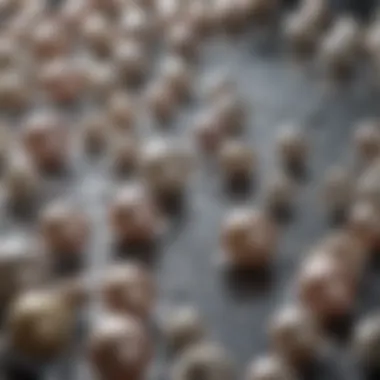
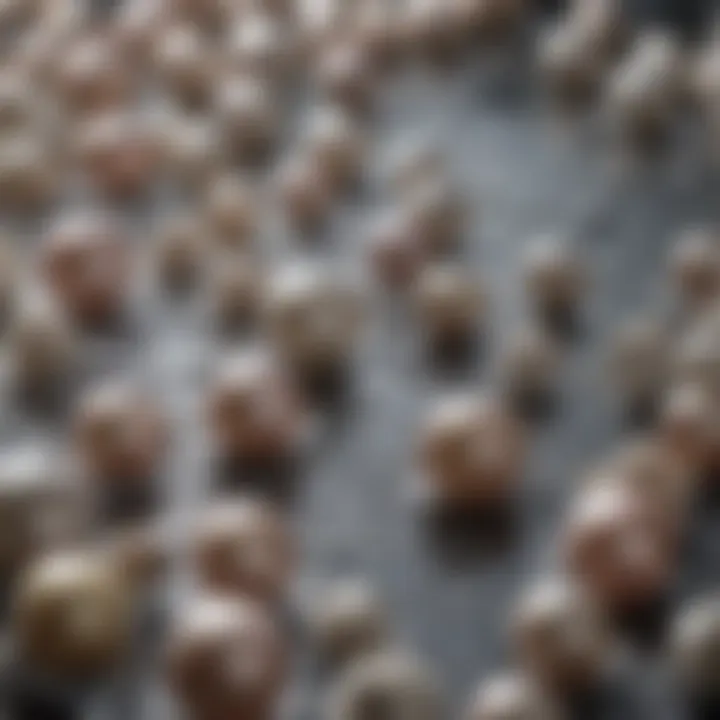
- Hyriopsis cumingii: Known for yielding high-quality pearls with thick nacre and a lustrous surface, this species is one of the most popular in pearl cultivation.
- Cristaria plicata: Though less common, pearls from this mollusk are typically larger but may have less luster than those from Hyriopsis.
Choosing the right species is paramount in pearl farming, as each type boasts its unique strengths and limitations. Examples of mollusk types show how species selection directly correlates with the potential quality and value of the pearls.
"Selecting the right species for cultivation is not just about size; it’s about the culture, the climate, and the quality of the yield."
Cultivation Techniques for Freshwater Pearls
This section explores the essential practices used in growing freshwater pearls, revealing how cultivation methods can significantly influence both the quality and quantity of harvested pearls. Given the growing interest in sustainable jewelry, understanding these techniques offers valuable insights into not just the pearl itself, but the broader implications for environmental stewardship and industry standards.
Traditional Methods
Most of the world’s freshwater pearls owe their origins to traditional cultivation practices that have been passed down through generations. These methods are steeped in time-tested wisdom, rooted in the symbiotic relationship between the mollusk and the farmer.
The most common traditional technique involves the careful selection of suitable freshwater mussels, which can thrive in clean rivers or lakes. Here’s a look at the key components:
- Seed Insertion: A small piece of shell or a bead is surgically implanted into the mantle tissue of a young mussel. This procedure requires precision and expertise. A skilled technician can enhance the mollusk's response to irritation, ultimately leading to the formation of a pearl.
- Environmental Monitoring: Farmers must ensure that the water quality is optimal. This includes checking for pollutants and maintaining proper pH levels. The health of the mussels is directly related to the surrounding ecosystem, making ecological awareness crucial.
- Harvesting Techniques: Once pearls have formed, the harvesting phase is approached with care. Many farmers choose to harvest only mature mussels, allowing them to continue producing pearls for subsequent harvests. This method preserves the population and enhances long-term sustainability.
These traditional methods, while effective, also rely heavily on the farmer's manual oversight and environmental conditions, which can vary from one region to another.
Modern Innovations in Cultivation
In recent times, the pearl cultivation industry has witnessed substantial shifts due to advancements in technology and scientific research. The introduction of modern techniques aims to enhance pearl quality and support sustainability measures. Here’s a glance at some notable innovations:
- Genetic Selection: By carefully selecting mollusk species with desirable traits, such as more robust nacre production and faster growth rates, cultivators can produce higher-quality pearls. Genetic research has opened new avenues for enhancing both resilience and beauty in pearls.
- Controlled Environments: With the implementation of closed-system aquaculture, farmers can regulate water temperatures and conditions, reducing exposure to diseases and parasites. These environments promote healthier mollusks, leading to a greater yield of higher-grade pearls.
- Use of Technology: Automated monitoring systems now allow for real-time analysis of water quality, keeping track of essential parameters like oxygen levels and contaminants. This shift towards precision farming empowers cultivators to make timely adjustments and ensures optimal conditions for pearl growth.
- Hybrid Techniques: Some cultivators are combining modern practices with traditional methods, benefiting from both worlds to enhance the efficiency and effectiveness of pearl farming.
The introduction of these modern techniques has revolutionized how freshwater pearls are cultivated, making the process not only more efficient but also more sustainable.
In essence, both traditional and modern cultivation techniques for freshwater pearls play a significant role in ensuring the continued success of this beautiful industry.
Harvesting and Processing Pearls
Harvesting and processing pearls is a vital component in the journey of freshwater pearls from their natural or cultivated environments to becoming coveted jewels. This stage not only marks the culmination of years of cultivation but also involves meticulous care to ensure that the pearls maintain their beauty and value. The techniques employed during this phase can greatly affect the quality and market appeal of the pearls.
Methods of Harvesting
The methods used for harvesting freshwater pearls can vary significantly depending on whether the pearls are collected from natural sources or farmed environments.
- Diving and Hand Harvesting: In natural pearl formations, divers often take the plunge to collect the mollusks by hand. This traditional method involves skilled divers navigating bodies of water, locating the pearl-producing mussels, and carefully prying them from their habitats. It's a labor-intensive process that requires a deep understanding of local ecosystems and considerable physical endurance.
- Mechanical Harvesting: In significantly larger pearl farms, mechanical harvesting has become commonplace. This method employs specialized equipment to harvest mussels from their beds in a more time-efficient manner. Though effective, it raises concerns regarding environmental impact and the delicate balance of aquatic habitats.
- Selective Harvesting: Cultivators often practice selective harvesting, choosing to only extract mussels that have reached a certain maturity. By doing this, they ensure that the remaining mussels continue to grow and can potentially produce more pearls for future harvests. This approach echoes an understanding of sustainability, giving farmers a chance to maintain long-term pearl production.
Post-Harvest Processing
The journey doesn't end once the pearls are harvested. Post-harvest processing is equally crucial, demanding the utmost care and precision.
- Cleaning: Freshwater pearls often require a thorough cleaning process to remove any residues from their time in the water. This typically involves gentle washing with warm water and mild soap, taking care not to damage the delicate nacre surface.
- Sorting and Grading: After cleaning, pearls are sorted based on several quality factors including luster, size, shape, and surface quality. Grading pearls correctly is essential for setting market prices and helps buyers understand the specific attributes of their selections.
- Drilling: Many freshwater pearls are drilled to facilitate stringing for jewelry making. This process requires precision to avoid cracking or chipping the pearls.
- Enhancements: Some pearl producers may treat pearls to enhance their color or luster. This can include dyeing or treatments to improve surface appearance. While these enhancements can increase marketability, genuine enthusiasts often prefer untreated pearls due to their natural beauty.
"The allure of a pearl lies not just in its exterior beauty, but also in the story it carries from the water to the jewelry box."
In summary, the techniques behind harvesting and processing freshwater pearls are essential for preserving their integrity and enhancing their aesthetic appeal. Understanding these methods gives insight into the dedication and meticulous care that go into bringing these natural wonders to consumers.
Market Dynamics and Trends
The market for freshwater pearls has evolved significantly in recent years, reflecting broader societal changes and consumer behaviors. The importance of understanding market dynamics cannot be overstated, particularly for gemstone enthusiasts and jewelry designers seeking to navigate this unique environment. The interplay of several factors—including consumer preferences, pricing strategies, and industry innovations—shapes the landscape of freshwater pearls, influencing everything from demand to ethical production practices.
Consumer Preferences
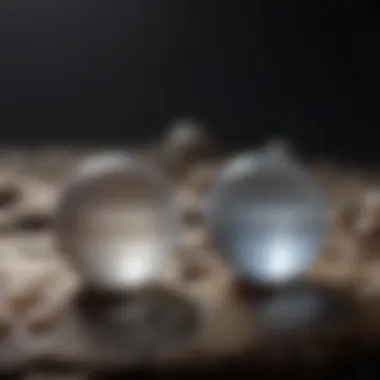
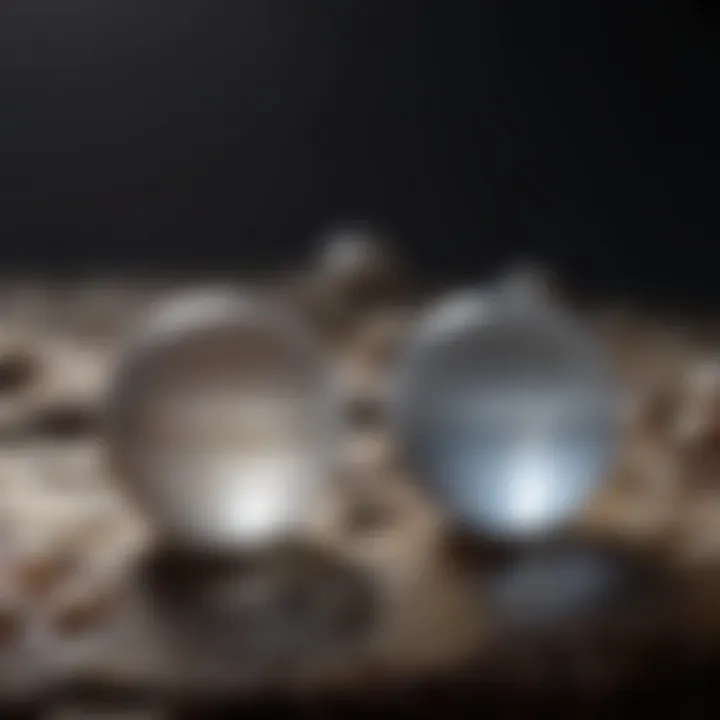
Consumer preferences regarding freshwater pearls are increasing in complexity. Many buyers are evolving, moving away from merely viewing pearls as decorative items to appreciating them as sustainable, eco-friendly investments. As more consumers become conscious of the environmental impact of their purchases, they lean towards brands that emphasize sustainability and ethical sourcing. Common trends include:
- Authenticity Over Imitation: There’s a growing desire for genuine and unique pieces. Shoppers prefer authentic freshwater pearls over synthetic options, valuing the story behind each pearl.
- Customization: Modern shoppers often seek personalized experiences. Designers who offer bespoke jewelry featuring freshwater pearls are attracting a loyal clientele.
- Versatility in Design: Freshwater pearls are gaining popularity in various types of jewelry, including fashion-forward pieces, which resonate with both younger and older demographics.
Understanding these preferences is crucial for stakeholders in this market. Jewelry designers need to adapt to these shifts, aligning their offerings with consumer desires to remain competitive.
Pricing Factors
The pricing of freshwater pearls is influenced by multiple factors that can create fluctuations in the market. Recognizing these elements is vital for both buyers and sellers. Key pricing factors include:
- Quality Attributes: Factors such as luster, surface quality, shape, and size play significant roles in determining pricing. High-quality pearls command premium prices, while less desirable characteristics can lead to lower valuations.
- Market Demand: As preferences for unique and ethically produced goods rise, prices can increase. Conversely, economic downturns may dampen demand, subsequently affecting prices.
- Production Costs: The cost of cultivation, including maintaining water quality and mollusk health, can impact the final price of freshwater pearls. Higher production costs often lead to higher retail prices.
- Supply Chain Factors: Disruptions in the supply chain, whether from environmental concerns or trade restrictions, can result in volatility in pearl prices.
These elements interplay within the larger context of the economy. Innovative strategies in pricing may also arise as stakeholders adjust to market conditions and consumer responsiveness. Understanding these dynamics offers valuable insight into the evolving landscape that characterizes the freshwater pearl market today.
"Consumer’s expectations are shifting towards responsible sourcing, and companies not adapting might find themselves left behind."
Through a thoughtful analysis of consumer preferences and pricing influences, stakeholders can make informed decisions that align with both market trends and their brand values.
Caring for Freshwater Pearls
Caring for freshwater pearls is crucial for maintaining their beauty and longevity. These delicate gems are organic in nature, created by living mollusks, which makes them unlike their mineral-based counterparts. Proper upkeep is essential to avoid damage and ensure that they continue to exude their characteristic luster. Here’s how to effectively clean and store fresh water pearls to keep them looking their best.
Cleaning Techniques
Cleaning freshwater pearls requires gentleness and precision. The key is avoiding harsh chemicals, which can strip away the natural nacre coating. Here are some tried-and-true techniques that can help:
- Use a Soft Cloth: A soft, lint-free cloth is your best friend. After wearing your pearls, gently wipe them down to remove any moisture, oils, or dirt.
- Mild Soap Solution: For a deeper clean, you can mix a few drops of mild liquid soap with warm water. Dip a soft cloth in the solution, wring it out until it's damp (not wet), and gently wipe each pearl. Avoid soaking them, as this can loosen the stringing.
- Avoid Ultrasonic Cleaners: Although these tools are popular for other jewelry types, they can be harmful to pearls. The vibrations could damage the pearls or their stringing.
"Freshwater pearls, while exquisite, demand care akin to that of a delicate flower in full bloom."
By following these steps, you can preserve the natural sheen of your pearls while avoiding unnecessary wear. Regular cleaning ensures your pearls retain their charm for generations.
Storage Recommendations
Proper storage of freshwater pearls is just as important as their cleaning. Because they are sensitive to changes in temperature and humidity, here are some effective storage guidelines:
- Keep Them Wrapped: Store your pearls in a soft pouch or wrap them in a soft cloth to prevent scratching. Avoid placing them with other jewelry to minimize friction.
- Humidity Control: Ideally, pearls should be kept in a slightly humid environment. This prevents them from drying out and cracking. Consider a jewelry box that can maintain some moisture.
- Avoid Plastic Containers: It's tempting to toss pearls into a plastic box, but this can trap moisture and encourage mildew. Instead, opt for a breathable fabric or wooden container.
In summary, caring for freshwater pearls involves a blend of gentle cleaning techniques and mindful storage habits. By committing to these practices, collectors and enthusiasts can ensure their radiant gems hold their beauty over time.
The Future of Freshwater Pearls
As we look forward, the future of freshwater pearls holds both promise and challenge. With the growing interest in sustainable sourcing and responsible gem cultivation, understanding how these elements intertwine with the pearl industry becomes essential. Freshwater pearls not only charm with their varied shapes and colors but also carry significant ecological and economic implications. The responsibility to preserve aquatic ecosystems while satisfying market demands lies at the heart of discussions about their future.
Sustainability Challenges
One of the foremost issues facing the freshwater pearl industry is sustainability. Over the years, the increasing popularity of freshwater pearls has put immense pressure on the natural habitats where the mollusks thrive. Key challenges include:
- Ecosystem Degradation: As demand rises, particularly in certain regions, practices that prioritize yield over ecological health can lead to the deterioration of local aquatic environments. Without careful management, this can endanger both pearl-producing mollusks and their ecosystems.
- Water Pollution: The health of freshwater ecosystems is directly linked to water quality. Agricultural run-off, industrial waste, and urban development contribute to water pollution, which negatively impacts the growth and quality of pearls. It’s imperative for farmers and industry stakeholders to implement strategies to minimize environmental harm.
- Overharvesting: Just as one might regard a treasure hoard, over-collecting pearls can lead to population declines in certain species. Establishing limits and protections for wild mollusk populations is critical for maintaining ecological balance while ensuring a sustained supply of pearls.
These sustainability challenges necessitate a collaborative approach among farmers, scientists, and policymakers to safeguard freshwater ecosystems while assuring the continued viability of the pearl market.
Innovations in Gemology
The need for innovation in gemology cannot be overstated when discussing the future of freshwater pearls. As this sector evolves, new technologies and practices are emerging to enhance the quality and sustainability of pearl production. Some noteworthy developments include:
- Selective Breeding: This technique aims to develop mollusk strains that not only produce higher quality pearls but are also more resilient to changes in water conditions. By utilizing genetic insights, breeders can create stronger, healthier species.
- Sustainable Farming Practices: Techniques that integrate ecological principles into farming practices are gaining traction. For example, polyculture systems that involve cultivating various species can enhance biodiversity and improve overall ecosystem health.
- Traceability Solutions: With the rise of consumers demanding transparency about their purchases, traceability systems are being introduced. These systems help consumers track the origin of their pearls, ensuring that they come from environmentally responsible sources.
"The evolution of pearl farming not only paves the way for more sustainable practices but also fosters innovations that align with consumer values in a conscientious market."
As these innovations take root, they can reshape public perception, ensuring that the allure of freshwater pearls remains intact while adapting to the needs of a changing world.
The future indeed depends on the balance of beauty and responsibility, making the path forward an exciting yet challenging journey.







